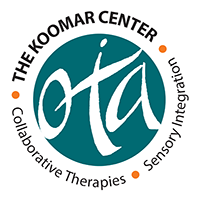Child Occupational Therapy Services
OTA The Koomar Center offers the highest quality services to children within the fields of Occupational Therapy and Speech and Language Therapy. This page describes the different types of Occupational Therapy evaluations that are offered at OTA as well as information on our intervention approaches.

Comprehensive OT Evaluation
Most children require a comprehensive evaluation in order to begin occupational therapy intervention. This evaluation will give you a complete picture of your child’s sensory processing and motor profile along with recommendations for services and accommodations. It includes 3 to 4 hours of direct assessment, a comprehensive detailed written report, and an evaluation feedback meeting. The assessment tools used for this evaluation vary depending on the child’s age, abilities and needs. Assessment tools utilized can include Sensory Integration and Praxis Tests (SIPT), Miller Assessment for Preschoolers (MAP), Ayres’ Clinical Observations, OTA-Watertown Sensory Modulation and Discrimination Evaluation, Bruininks-Oseretesky Test of Motor Proficiency, or a number of other assessment tools.
Abridged OT Evaluation
Individuals whose evaluation is covered by Harvard Pilgrim Health Care (HPHC) insurance plans are eligible for our abridged evaluations. This evaluation includes 45 minutes to 1 hour of assessment and includes a brief two-page written report. An evaluation feedback meeting is strongly encouraged to understand the results of the evaluation and our approach to intervention. These meetings are not covered by this insurance plan but are offered at a discounted rate. This evaluation is not comprehensive, but it is sufficient to determine eligibility for occupational therapy services.
Specialty OT Evaluation
On occasion children may benefit from a detailed evaluation that is focused on a specific area such as fine motor/handwriting skills, eating and mealtime performance, listening or visual-vestibular integration. OTA’s specialty evaluations are helpful for examining a specific area of function in an in-depth way to effectively guide intervention. These are recommended when a child is experiencing an isolated area of difficulty, when an area is identified in another evaluation, or over the course of therapy indicates the need for additional assessment. Our specialty evaluations include 1.5-2 hours of assessment, a written report, and an evaluation feedback meeting.
Occupational Therapy Screening
In rare instances, an occupational therapy screening may be recommended. For individuals who currently receive services at OTA The Koomar Center, a screening might be recommended to begin to explore the potential benefit of other services. This might include screening sensory motor capacities or determining if an adjunctive service such as cranio-sacral therapy or listening intervention may be appropriate.
For individuals who are new to OTA, an occupational therapy screening might be recommended during the intake process if it is unclear if the reported concerns are sensory related. In this case, a screening can take place as a first step instead of a comprehensive evaluation. The results of the screening will guide if a comprehensive evaluation is recommended.
A screening consists of a 1-hour screening session; a feedback checklist is provided at the end of the screening.
Occupational Therapy Intervention
The occupational therapy intervention provided at OTA is tailored to meet the individual needs of each child and family. Therapy sessions are focused on providing enhanced and targeted sensory input, together with motor challenges, to engage the child in the “just right challenge” to promote an organized and developed nervous system. Therapy occurs within the context of play as the therapist and child work together to engage in meaningful activities to improve the sensory motor foundations needed to improve a range of functional skills including:
- Completion of daily activities such as getting dressed
- Participation in social and play environments
- Negotiating environment in a safe and coordinated manner
- Attending and participating in school
- Sleep and eating patterns
- Engaging in new activities more comfortably
- Accepting everyday sensations including clothing and noisy environments
At the core of our work is developing a therapeutic relationship that allows for growth in a physically and emotionally safe environment. This is achieved through including the child in the therapeutic process and including their areas of interest. In addition, therapists are thoughtful about what other factors that might need to be considered to support a child’s needs. This might include setting up a room in a specific way, considering parent involvement in sessions, and determining if it makes sense to work in a quiet small room or to join other children with their therapists in a shared space.
Our once to twice weekly hour-long therapy sessions encompasses direct care, parent education and recommendations for support in functional settings such as home and school. Your therapist will consider and utilize a range of approaches during therapy to support the unique needs of your child including listening programs, oral motor approaches, manual therapies and visual vestibular modalities. Additional supplemental services, including collaboration and meeting with parents and team members, are also available to comprehensively support you and your child. The development of functional goals and objectives for each child is a very important part of the treatment planning process. We look forward to meeting with you during the first month of therapy to establish functional goals that will be measured by improvement in day-to-day skills and activities.
Specialty Occupational Therapy Interventions
Listening Interventions
The use of auditory interventions as a therapeutic tool (also called sound therapy) has grown significantly in recent times. These music based programs facilitate sensory processing by impacting the auditory and vestibular sensory systems. Clinical outcomes following a sound therapy program can include improved self-regulation, attention, communication, temporal-spatial organization, motor control, visual motor skills, handwriting and reading. Music based sound stimulation programs originated in the work of Dr. Alfred Tomatis, MD, a French ear, nose and throat specialist. In the 1950s Dr. Tomatis developed the first auditory training program called the Tomatis Method. Generally the principles and theories of Tomatis provide the foundation for other auditory intervention programs. Currently OTA offers three different types of auditory intervention: Integrated Listening Systems (ILS) The Listening Program (TLP) and Therapeutic Listening. All programs utilize specially modified music which can be used within treatment sessions and carried over in a home program. They differ in the structure of the program implementation. For more information describing the listening interventions at OTA, click here.
Visual-Vestibular Intervention
- Crave constant physical support from adults, such as being held, rocked, guided, etc.
- Have difficulty with going up or down stairs
- Get car sick frequently or generally dislike rides in the car
- Avoid swings or playground equipment
- Experience delays with reading and writing
- Have difficulty with gross motor skills such as riding a bike, ball skills, running, or jumping
- Stumble or fall frequently
- Not seem to get dizzy even after spinning for a long time
- Seem to enjoy fast movement like swinging
Visual vestibular intensives at OTA are typically of a three-week duration where the individual attends for 3 to 4 sessions a week working one-on-one with a therapist. Following the three-week intensive the therapist will discuss the recommended course of action. This may include discharge from therapy, continued therapy once a week, or a break from therapy to allow for the information to be integrated before continuing with more therapy. Click here for more information on Visual Vestibular integration.
The FOCUS Program – Oral Motor/Feeding Intervention
Manual Therapies
Many therapists at The Koomar Center specialize in manual therapies and routinely use these techniques as an integral part of therapy sessions. Sessions specifically devoted to manual therapy are also offered. These sessions may precede or follow the regularly scheduled sensory integration sessions, depending upon the individual’s tolerance. Parents are encouraged to remain with children during manual therapy sessions (at least initially) in order to observe the techniques and their effects. Click here for more information.
Yikes Bikes
Under the best circumstances, mastering the art of bike riding can be difficult for many individuals. For those who have sensorimotor issues, the task can be even more daunting. Learning to ride a bide requires many foundation skills including good body awareness, balance, postural stability, visual skills, bilateral skills and motor planning. Individuals may also be anxious and appear unmotivated if they have not been able to master riding their bike with the same ease as peers and siblings. At OTA individual bike-riding instruction is given to children who are not yet riding their bikes or have limited skills. Taught by experienced OTA therapists, these lessons are tailored to meet the needs of each child. The number of sessions required depends on the child’s skill level. Don’t forget to bring your bike and helmet to the lesson! Just fill out a Bike Intake Form, and we’ll contact you. Click here for a Bike Intake Form.
